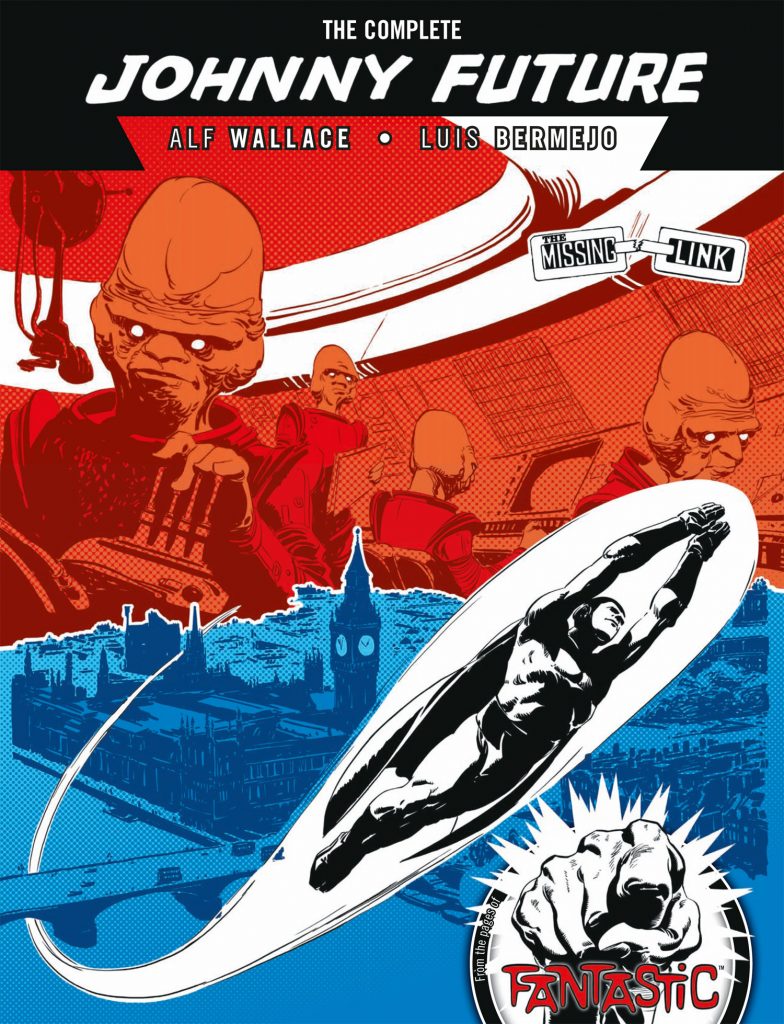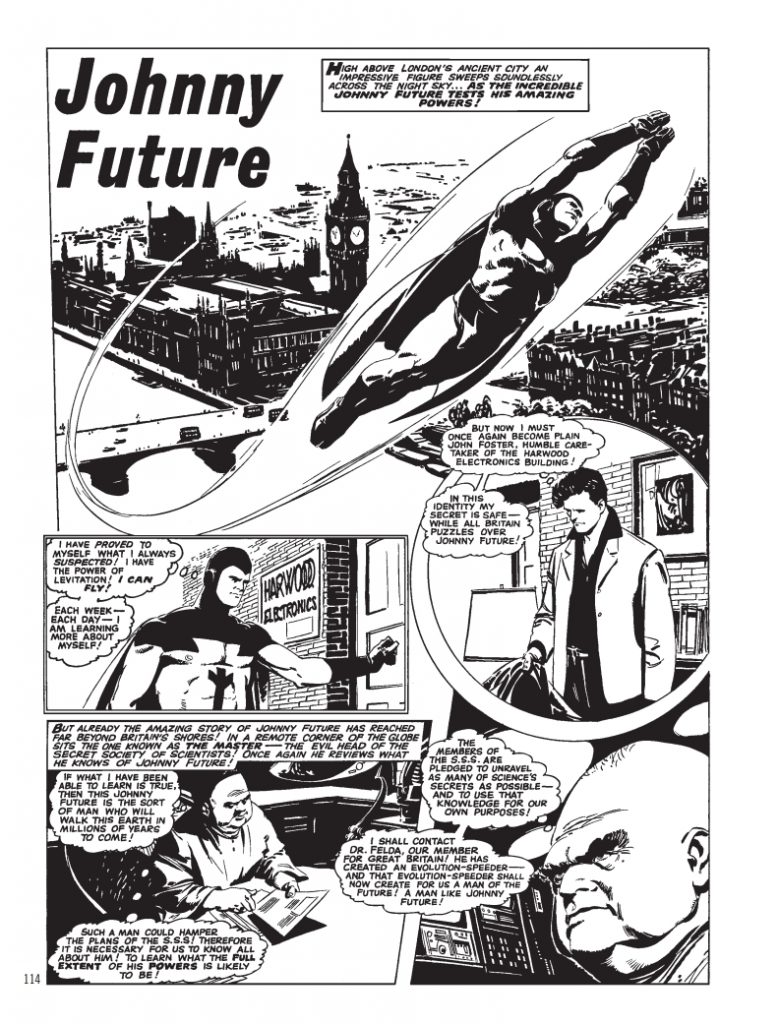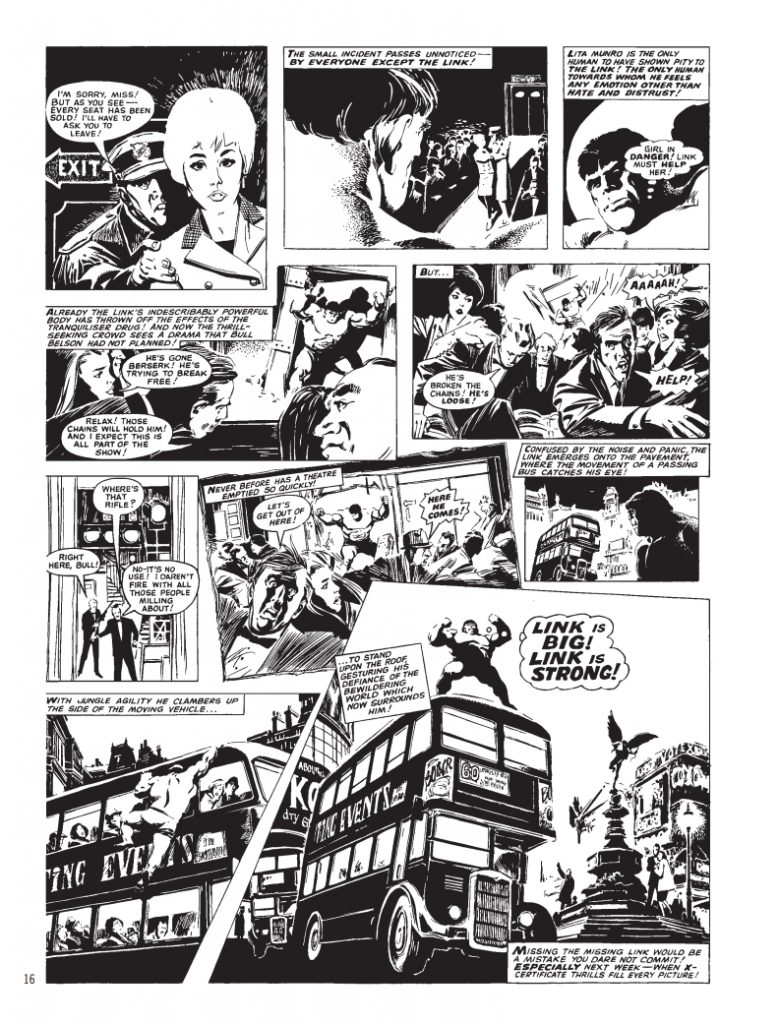 Review by Peter Duncan
Review by Peter Duncan
Written by Alf Wallace
Art by Luis Bermejo
Out: 30th April 2020
Publisher: Rebellion (Treasury of British Comics)
The Book: “The Missing Link’ – a creature of limitless strength, is drawn to Britain in pursuit of an expedition party he encountered in his homeland. The man-ape causes havoc, until he accidentally stumbles into an experimental nuclear research facility and is bombarded by radiation. Instead of killing him, the creature evolves into an advanced human.
Now possessing a genius mind, super-strength, enhanced senses and the ability to fly, as Johnny Future he protects mankind from such sinister beings as The Master, Disastro, Animal Man and the Secret Society of Scientists…

The Review: One of the delights of Rebellion’s “Treasury of British Comics” imprint is the unpredictability of the strips they select for reprinting. With Johnny Future, they have selected a real oddity.
The strip appeared in Fantastic, the fourth title in Odhams Press Power Comics Line, which launched in February 1967. Following on from the success of including cut-up and reorganised Marvel Superhero strips in the otherwise more traditional Wham!, Smash! and Pow!, Fantastic was totally dominated by the superheroes from across the Atlantic.

Published at a size that approximated the proportions of US comics, so as to avoid the cutting up and re-laying out of pages that occurred in those titles, Fantastic initially reprinted complete Thor and Iron Man stories, with issues of X-Men split across two issues. It featured letters pages and text that matched the jaunty tone of Stan Lee and had back cover pin-ups of Marvel characters, occasionally drawn by a young Jack Kirby-influenced Barry Smith, among others. In almost every way, Fantastic looked like a black and white version of an American comic – apart from “Johnny Future”.
The strip opened under a different title, “The Missing Link“, and was written by Alf Wallace, the Managing Editor of Odhams Press, who would go on to work at Marvel UK in the 1970s, with art by Luis Bermejo, who’s earlier work included later “Heros the Spartan” stories for Eagle and, later, strips for US publishers Warren and DC Comics.
It’s hard to escape the conclusion that “Johnny Future” was designed as a “page-filler”, a strip that used up space left by the variable lengths of American imports. Episodes could be anything from two to five pages, depending on the page count of the lead strips.
The intent seems to have been to create a British version of a Marvel hero, with super-powers, secret identities and a set of increasingly bizarre villains, many of whom seem to be mutated versions of existing Marvel characters. The execution, however, was much more like a standard British strip of the time, with no time for long-drawn out origin stories or fight scenes.

It takes just a single page to set the scene. Opening with a character who looks very like the Incredible Hulk, we then watch as a teacher tells a class of schoolboys about the theories of “evolutionists” and the huge gulf between “even the highest ape and the most primitive man’”. He explains that “there must have once existed a creature halfway between an ape and a man… A Missing Link”.
By the end of the page, we’ve found out that one of the pupils in that classroom, now an adult, has become an exploiter of natural oddities, that he is in Africa and that there is a creature called “The Goma” (the word means Link), on “Dead Mountain” that he intends to capture. The final two panels on the page introduce the creature, who talks in the third person, wears torn trousers and a belt like the Hulk, and refers to himself as “The Link” – although how he knows he is a missing link is never actually explained.
What follows is a story of capture and a rampage through London which ends when a scientific accident mutates the Link into a super-evolved human who becomes the costumed hero, Johnny Future, which is where the strip really takes off and becomes much more than a Hulk/King Kong rip-off.

The newly intelligent Link is a more interesting character. He has doubts, a love interest and gets involved in the use and abuse of science by foolish and villainous scientists; and artist Luis Bermejo, seems to find his feet on the strip at this point as well. Alf Wallace’s scripts seem to allow him more room to work – and it shows, particularly in a sequence featuring “The Animal Man’, where he is allowed to flex his artistic muscle.
From then on, we have increasingly weird supervillains, robots and evil secret societies all told in densely plotted, beautifully drawn short episodes.

I read Fantastic when it first came out and was not a fan of “Johnny Future”. It got in the way of the flashy, less wordy superhero strips that I bought the comic for. But on re-reading, I’ve really enjoyed it as both an oddity and a precursor of the influence superhero comics would have on British comics in general. This collection contains all of the episodes of both “The Missing Link” and “Johnny Future”, including a colour story from the 1968 Fantastic Annual.
I couldn’t help but relate it back to “MACH One” in the early 2000AD and I wonder if it was, even subconsciously, an influence on that story.
Johnny Future is very much of its time, Wallace really did pile it on in terms of word count, but he crammed a lot into his limited page count and produced a fascinating mix of the British style of comic storytelling and the American superhero strip.




Bermejo’s art got better and better as the series continues. There are sequences and panels as striking as anything seen in British comics at the time. He would go on to work on educational comics, like Look and Learn, in the UK and become one of the most prolific artists for the Warren titles Eerie, Creepy and Vampirella in the US publisher’s final decade.
An oddity? Certainly. A strange choice for reprinting? Perhaps. But is “Johnny Future” a strip worthy of being better remembered than it has been to date? Most definitely!
Peter Duncan
• Johnny Future is due to be published on 30th April 2020. It is available for pre-order from Amazon and on sale from the 2000AD on-line shop
Peter Duncan is editor of Sector 13, Belfast’s 2000AD fanzine and Splank! – an anthology of strips inspired by the Odhams titles, Wham!, Smash! and Pow! He’s also writer of Cthulhu Kids. Full details of his comics activities can be found on his webpage at www.boxofrainmag.co.uk
Peter Duncan is editor of Sector 13, Belfast’s 2000AD fanzine and Splank! – an anthology of strips inspired by the Odhams titles, Wham!, Smash! and Pow! He’s also writer of Cthulhu Kids. Full details of his comics activities can be found at www.boxofrainmag.co.uk
Categories: British Comics, downthetubes Comics News, downthetubes News, Reviews
 In Review: The Leopard from Lime Street – Birthright
In Review: The Leopard from Lime Street – Birthright  In Review: Psycho Gran Comic Capers Cavalcade by David Leach
In Review: Psycho Gran Comic Capers Cavalcade by David Leach  In Pictures and Review: Lawless 2024
In Pictures and Review: Lawless 2024  Shaman Kane storms back into action for an action-packed finale to latest adventure
Shaman Kane storms back into action for an action-packed finale to latest adventure